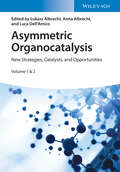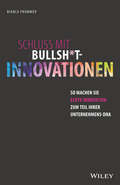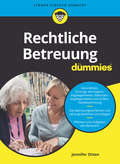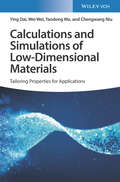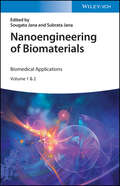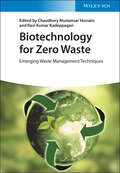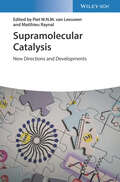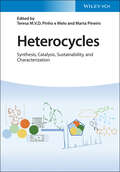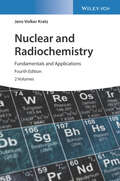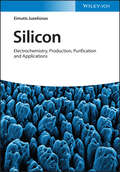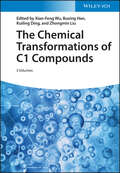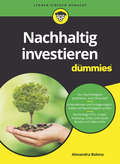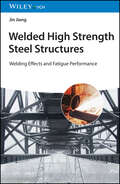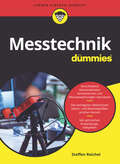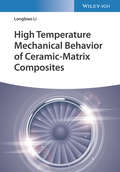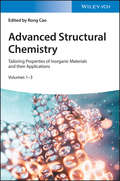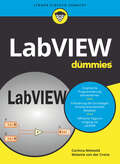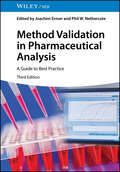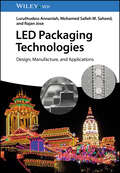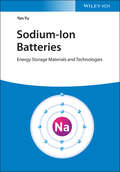- Table View
- List View
Der Wau-Effekt: Mit tierischer Unterstützung zu mehr innerer Stärke und Gelassenheit
by Michaela KnabeWas machen die Menschen anders, die trotz Misserfolgen, Krisen und stürmischer Phasen den Kopf nicht in den Sand stecken? Die ihre täglichen Herausforderungen souverän und gelassen meistern, sich schnell von Rückschlägen erholen und sogar gestärkt daraus hervorgehen? Sie verfügen über die sogenannte Resilienz, die psychische Widerstandskraft. Diese innere Stärke sorgt dafür, dass Menschen trotz hoher Anforderungen leistungsstark und handlungsfähig bleiben - auch in stürmischen Zeiten. Das Buch von Michaela Knabe erläutert, wie die Arbeit mit dem "Co-Trainer" Hund dazu beitragen kann, diese innere Stärke zu entwickeln. Hunde sind von Natur aus resilient und daher die perfekten Lehrmeister für persönliches Wachstum. Am Beispiel von 10 Faktoren wird jeweils aus menschlicher und Hund-Perspektive beschrieben, welche Bedeutung diese Kompetenzen für die persönliche Resilienz haben. Lassen Sie sich mitreißen vom "Wau-Effekt" des Buches und lernen Sie von unserem Partner mit der kalten Schnauze.
Asymmetric Organocatalysis: New Strategies, Catalysts, and Opportunities, 2 Volumes
by Lukasz AlbrechtAsymmetric Organocatalysis Comprehensive resource on the latest and most important developments in the highly vivid field of asymmetric organocatalysis The book provides a comprehensive overview of the most important advancements in the field of asymmetric organocatalysis that have occurred within the last decade. It presents valuable examples of newly developed synthetic methodologies based on various organocatalytic activation modes. Special emphasis is given to strategies where organocatalysis is expanding its potential by pushing the boundaries and founding new synergistic interactions with other fields of synthetic chemistry, such as metal catalysis, photocatalysis, and biocatalysis. The application of different concepts (such as vinylogy, dearomatization, or cascade reactivity), resulting in the development of new functionalization strategies, is also discussed. Sample topics covered within the book include: New developments in enantioselective Brønsted acid catalysis with strong hydrogen-bond donors Asymmetric phase-transfer catalysis, from classical applications to new concepts Halogen-bonding organocatalysis Asymmetric electrochemical organocatalysis and synergistic organo-organocatalysis Immobilized organocatalysts for enantioselective continuous flow processes Mechanochemistry and high-pressure techniques in asymmetric organocatalysis Useful tools in elucidation of organocatalytic reaction mechanisms With an overall focus on new reactions and catalysts, this two-volume work is an indispensable source for everyone working in the field of asymmetric organocatalysis.
Schluss mit Bullsh*t-Innovationen: So machen Sie echte Innovation zum Teil Ihrer Unternehmens-DNA
by Bianca PrommerIn vielen Unternehmen wird heute Bullshit-Bingo gespielt. Die Geschäftsführung ordnet Innovation an, weil "man" das ja so macht. Leider bleibt es dabei meist bei oberflächlichen und oft falsch aufgebauten Innovationsaktivitäten. Innovation quasi als Alibihaltung. In der Unternehmenshierarchie angeordnet von "oben nach unten". Das kann nicht funktionieren. Denn nur das, was Mitarbeiter selbst mitgestalten, wofür sie selber brennen, kann zum integralen Teil der Unternehmens-DNA werden. Innovation sollte daher in Unternehmen auf allen Ebenen in "Fleisch und Blut" übergehen. Nur dann kann echte Innovation stattfinden. In ihrem Buch fordert Bianca Prommer dazu auf, innovatives Denken in den Unternehmen zur automatisch ablaufenden Kompetenz zu machen, denn schließlich denken wir auch nicht übers Atmen nach. Sie zeigt auf, wie der Weg zu einer jeweils auf das individuelle Unternehmen angepassten Innovationsstrategie funktioniert, wenn Unternehmen den im Buch erläuterten Schritten folgen. Die Autorin legt dar, warum es nichts bringt, innovative Blaupausenkonzepte von anderen Unternehmen zu übernehmen und erklärt, welche Innovationsmodelle im unternehmerischen Alltag, im dringlichen und harten Tagesgeschäft tatsächlich funktionieren. Umgesetzt wird das Thema anhand der - immer wieder von Fakten und praxisnahem Wissens-Input unterstützten, sich durch das Buch ziehenden - Geschichte der fiktiven Frisch & Schnell GmbH, einem produzierenden Traditionsunternehmen mit 250 Mitarbeitern. Strategisch in jedem Kapitel platzierte Reflexionsfragen, fordern den Leser innerhalb der Lektüre immer wieder auf, den eigenen Gedanken- und Handlungsstand zum Thema Innovation auf den Prüfstand zu stellen und intensiv zu hinterfragen. Die "Anti-Bullshit-Fakten" am Ende jeden Kapitels dienen der fachlichen Zusammenfassung der wichtigsten Erkenntnisse zur Umsetzung in der Praxis.
Rechtliche Betreuung für Dummies (Für Dummies)
by Jennifer OttenAls rechtlicher Betreuer muss man vieles wissen. Jennifer Otten stellt Ihnen in diesem Buch die wesentlichen Regelungen in der Beziehung zwischen Betreuer und Betreuten dar. Sie erklärt Ihnen die Bedeutung und das Zusammenspiel der Gerichte und Behörden im Betreuungsverfahren. Dieses Buch ist anwendungsorientiert und praxisnah, eine Schritt-für-Schritt-Anleitung für rechtliche Betreuer voller Checklisten, Tipps und Tricks, die Sie bei Ihrer Tätigkeit als ehrenamtlicher Betreuer unterstützen oder Ihnen den Einstieg in die berufliche Betreuung erleichtern.
Calculations and Simulations of Low-Dimensional Materials: Tailoring Properties for Applications
by Wei Wei Ying Dai Yandong Ma Chengwang NiuCalculations and Simulations of Low-Dimensional Materials A comprehensive guide to methods for calculating and simulating the properties of low-dimensional materials Two-dimensional materials are those, such as graphene and 2D oxides, whose thickness is so small as to approach the atomic scale. Potential applications for these materials exist in an enormous range of scientific and industrial fields. A previous era of low-dimensional materials focused on direct experimentation to demonstrate the properties, reactions, and potential applications of these materials; however, in recent years, calculation and simulation have been shown to have considerable predictive power, reducing the period between design and deployment of these potentially critical materials. Calculations and Simulations of Low-Dimensional Materials offers the first comprehensive survey of this exciting new approach to low-dimensional materials. It guides readers through the foundational physics and through a range of calculation and simulation methods, each with different predictive capacities. Mastery of these methods will enable readers to narrowly tailor the properties of particular materials towards real-world applications, providing confidence in the underlying mechanics and in the range of possible outcomes. Calculations and Simulations of Low-Dimensional Materials readers will also find: Broad coverage of material properties, including electronic, spin, magnetic, photonic, optical, electrochemical and transport properties Discussion of potential applications in areas such as electronics, spintronics, and valleytronics Examination of further potential applications regarding quantum Hall phase, photonics, optoelectronics, multiferroic, and photocatalysis Calculations and Simulations of Low-Dimensional Materials is a useful reference for materials scientists, electrochemists, inorganic chemists, physical chemists, photochemists, and the libraries that support these professions.
Nanoengineering of Biomaterials: Drug Delivery & Biomedical Applications
by Sougata Jana Subrata JanaA comprehensive discussion of various types of nanoengineered biomaterials and their applications In Nanoengineering of Biomaterials: Drug Delivery & Biomedical Applications, an expert team of chemists delivers a succinct exploration of the synthesis, characterization, in-vitro and in-vivo drug molecule release, pharmacokinetic activity, pharmacodynamic activity, and the biomedical applications of several types of nanoengineered biomaterials. The editors have also included resources to highlight the most current developments in the field. The book is a collection of valuable and accessible reference sources for researchers in materials chemistry and related disciplines. It uses a functions-directed approach to using organic and inorganic source compounds that translate into biological systems as scaffolds, micelles, dendrimers, and other delivery systems. Nanoengineering of Biomaterials offers readers up-to-date chemistry and material science insights that are readily transferrable to biomedical systems. The book also includes: Thorough introductions to alginate nanoparticle delivery of therapeutics and chitosan-based nanomaterials in biological applications Comprehensive explorations of nanostructured carrageenan as a drug carrier, gellan gum nanoparticles in drug delivery, and guar-gum nanoparticles in the delivery of bioactive molecules Practical discussions of protein-based nanoparticles for drug delivery, solid lipid nanoparticles as drug carriers, and pH-responsive nanoparticles in therapy In-depth examinations of stimuli-responsive nano carriers in drug targeting Perfect for pharmaceutical chemists, materials scientists, polymer chemists, life scientists, and medicinal chemists, Nanoengineering of Biomaterials: Drug Delivery and Biomedical Applications is also an indispensable resource for biologists and bioengineers seeking a one-stop reference on the transferability of materials chemistry and nanotechnology to biomedicine.
Biotechnology for Zero Waste: Emerging Waste Management Techniques
by Chaudhery Mustansar Hussain Ravi Kumar KadeppagariBiotechnology for Zero Waste The use of biotechnology to minimize waste and maximize resource valorization In Biotechnology for Zero Waste: Emerging Waste Management Techniques, accomplished environmental researchers Drs. Chaudhery Mustansar Hussain and Ravi Kumar Kadeppagari deliver a robust exploration of the role of biotechnology in reducing waste and creating a zero-waste environment. The editors provide resources covering perspectives in waste management like anaerobic co-digestion, integrated biosystems, immobilized enzymes, zero waste biorefineries, microbial fuel cell technology, membrane bioreactors, nano biomaterials, and more. Ideal for sustainability professionals, this book comprehensively sums up the state-of-the-art biotechnologies powering the latest advances in zero-waste strategies. The renowned contributors address topics like bioconversion and biotransformation and detail the concept of the circular economy. Biotechnology for Zero Waste effectively guides readers on the path to creating sustainable products from waste. The book also includes: A thorough introduction to modern perspectives on zero waste drives, including anaerobic co-digestion as a smart approach for enhancing biogas production Comprehensive explorations of bioremediation for zero waste, biological degradation systems, and bioleaching and biosorption of waste Practical discussions of bioreactors for zero waste and waste2energy with biotechnology An in-depth examination of emerging technologies, including nanobiotechnology for zero waste and the economics and commercialization of zero waste biotechnologies Perfect for process engineers, natural products, environmental, soil, and inorganic chemists, Biotechnology for Zero Waste: Emerging Waste Management Techniques will also earn a place in the libraries of food technologists, biotechnologists, agricultural scientists, and microbiologists.
Supramolecular Catalysis: New Directions and Developments
by Piet W.N.M. van Leeuwen Matthieu RaynalSupramolecular Catalysis Provides a timely and detailed overview of the expanding field of supramolecular catalysis The subdiscpline of supramolecular catalysis has expanded in recent years, benefiting from the development of homogeneous catalysis and supramolecular chemistry. Supramolecular catalysis allows chemists to design custom-tailored metal and organic catalysts by devising non-covalent interactions between the various components of the reaction. Edited by two world-renowned researchers, Supramolecular Catalysis: New Directions and Developments summarizes the most significant developments in the dynamic, interdisciplinary field. Contributions from an international panel of more than forty experts address a broad range of topics covering both organic and metal catalysts, including emergent catalysis by self-replicating molecules, switchable catalysis using allosteric effects, supramolecular helical catalysts, and transition metal catalysis in confined spaces. This authoritative and up-to-date volume: Covers ligand-ligand interactions, assembled multi-component catalysts, ligand-substrate interactions, and supramolecular organocatalysis and non-classical interactions Presents recent work on supramolecular catalysis in water, supramolecular allosteric catalysis, and catalysis promoted by discrete cages, capsules, and other confined environments Highlights current research trends and discusses the future of supramolecular catalysis Includes full references and numerous figures, tables, and color illustrations Supramolecular Catalysis: New Directions and Developments is essential reading for catalytic chemists, complex chemists, biochemists, polymer chemists, spectroscopists, and chemists working with organometallics.
Heterocycles: Synthesis, Catalysis, Sustainability, and Characterization
by Teresa M.V.D. Pinho e Melo Marta PineiroA must-read handbook on heterocycle chemistry with a focus on sustainability Heterocycles feature prominently in our daily life—they are essential for pharmaceuticals, agrochemicals, and fine chemicals. More, numerous natural, bioactive products contain heterocyclic compounds. As a result, heterocyclic chemistry continues to be one of the most important areas of study in organic chemistry. Heterocycles provides an important reference on a wide range of topics relating to heterocyclic chemistry, with a heavy emphasis on sustainable methods and greener syntheses. The book describes state-of-the-art synthetic methods, such as photochemical reactions, dearomatization reactions, organocatalysis, transition metal catalysis, and biocatalysis. It also covers: Sustainable methods, like flow chemistry, mechanochemistry, and multicomponent synthesis Strategies for the synthesis of heterocyclic macrocycles and medium-sized rings Characterization of heterocyclic compounds Heterocycles is a useful reference for organic chemists, natural products chemists, catalytic chemists, and medicinal chemists in academia and industry.
Nuclear and Radiochemistry: Fundamentals and Applications
by Jens-Volker KratzThe leading resource for anyone looking for an accessible and authoritative introduction to nuclear and radiochemistry In the newly revised Fourth Edition of Nuclear and Radiochemistry: Fundamentals and Applications, distinguished chemist Jens-Volker Kratz delivers a two-volume handbook that has become the gold standard in teaching and learning nuclear and radiochemistry. The books cover the theory and fundamentals of the subject before moving on the technical side of nuclear chemistry, with coverage of nuclear energy, nuclear reactors, and radionuclides in the life sciences. This latest edition discusses the details and impact of the Chernobyl and Fukushima nuclear disasters, as well as new research facilities, including FAIR and HIM. It also incorporates new methods for target preparation and new processes for nuclear fuel recycling, like EURO-GANEX. Finally, the volumes extensively cover environmental technological advances and the effects of radioactivity on the environment. Readers will also find: - An accessible and thorough introduction to the fundamental concepts of nuclear physics and chemistry, including atomic processes, classical mechanics, relativistic mechanics, and the Heisenberg Uncertainty Principle - Comprehensive explorations of radioactivity in nature, radioelements, radioisotopes and their atomic masses, and other physical properties of nuclei - Practical discussions of the nuclear force, nuclear structure, decay modes, radioactive decay kinetics, and nuclear radiation - In-depth examinations of the statistical considerations relevant to radioactivity measurements Written for practicing nuclear chemists and atomic physicists, Nuclear and Radiochemistry: Fundamentals and Applications is also an indispensable resource for nuclear physicians, power engineers, and professionals working in the nuclear industry.
Silicon: Electrochemistry, Production, Purification and Applications
by Eimutis JuzeliunasSilicon The expert reference on sustainable and energy-efficient production of photovoltaic-grade silicon materials Electrochemical methods, in particular molten-salt approaches, are a cost-effective, energy-efficient, and highly sustainable approach for producing solar-grade silicon. Surface micro- and nanostructuring methods for effective light harvesting, silicon electrorefining in molten salts, electrodeposition of photoresponsive films, and other related processes are likely to replace conventional carbothermic production methods. Silicon: Electrochemistry, Production, Purification and Applications presents an up-to-date summary of recent experimental and technological developments in the field, highlighting sustainable and energy-efficient processes for high-grade silicon production for a variety of photovoltaic and energy applications. Presented in a logical and concise format, this authoritative volume details the fundamental properties and technical processes of metal-grade silicon production and describes the various electrochemical methods for high-grade silicon production. Topics include silicon surface modification, chemical-physical structuring, porous and black silicon, electrochemical Si surface structuring and anodizing in molten salts, and more. Reviews the sustainable and energy-efficient production and purification of photovoltaic-grade silicon materials Summarizes recent progress in sustainable processes for high-grade silicon production Describes electrochemical methods for silicon production such as electrolysis, electrodeposition, and electrorefining Concludes with a discussion of future challenges and opportunities Written by a leading researcher in the field, Silicon: Electrochemistry, Production, Purification and Applications is a valuable resource for chemists and material scientists in academia and industry, particularly those working in sustainable energy development, photovoltaics, light harvesting efficiency, solar-to-chemical conversion, and production of solar-grade silicon, batteries, photoelectrodes, or silicon-based semiconductors.
The Chemical Transformations of C1 Compounds
by Xiao-Feng Wu Kuiling Ding Buxing Han Zhongmin LiuThe Chemical Transformations of C1 Compounds A comprehensive exploration of one-carbon molecule transformations The chemistry of one-carbon molecules has recently gained significant prominence as the world transitions away from a petroleum-based economy to a more sustainable one. In The Chemical Transformations of C1 Compounds, an accomplished team of chemists delivers an in-depth overview of recent developments in the field of single-carbon chemistry. The three-volume book covers all major C1 sources, including carbon monoxide, carbon dioxide, methane, methanol, formic acid, formaldehyde, carbenes, C1 halides, and organometallics. The editors have included resources discussing the main reactions and transformations into feedstock chemicals of each of the major C1 compounds reviewed in dedicated chapters. Readers will discover cutting-edge material on organic transformations with MeNO2, DMF, DCM, methyl organometallic reagents, CCl4, CHCl3, and CHBr3, as well as recent achievements in cyanation reactions via cross-coupling. The book also offers: Thorough introductions to chemical transformations of CH4, methods of CH4 activation, chemical transformations of CH3OH and synthesis alkenes from CH3OH Comprehensive explorations of the carbonylation of MeOH, CH2O in organic synthesis, organic transformations of HCO2H, and hydrogen generation from HCO2H Practical discussions of the carbonylation of unsaturated bonds with heterogeneous and homogeneous catalysts, as well as the carbonylation of C(sp2)-X bonds and C(sp3)-X bonds In-depth examinations of carbonylative C-H bond activation and radical carbonylation Perfect for organic and catalytic chemists, The Chemical Transformations of C1 Compounds is also an ideal resource for industrial chemists, chemical engineers, and practitioners at energy supply companies.
Nachhaltig investieren für Dummies (Für Dummies)
by Alexandra BolenaSie wollen mit Ihren Geldgeschäften die Welt ein bisschen besser machen? Ihr Erspartes in Unternehmen mit einer nachhaltigen Geschäftsidee investieren, die umweltfreundlich und fair wirtschaften und vielleicht sogar noch soziale Projekte unterstützen? Dieses Buch gibt Ihnen Tipps für die Auswahl von nachhaltigen Aktien, Anleihen, ESG-konformen Fonds und ETFs. Darüber hinaus gibt es für Sie als nachhaltig orientierten Anleger aber noch eine Vielzahl anderer innovativer Möglichkeiten, Ihr Geld "gut" anzulegen: Lesen Sie alles über Green und Social Bonds, Investments in nachhaltige Sachwerte, Mikrofinanz oder Crowdinvesting und warum eines dieser Themen sicher auch zu Ihren Vorstellungen passt. Erfahren Sie, wie Sie echte nachhaltige Angebote von solchen, die "Green-washing" betreiben, unterscheiden, warum die SDGs eine gute Messlatte sind, was Gütesiegel aussagen und last but not least warum auch Ihre Hausbank einen Beitrag leisten kann und wie Sie dieser in Sachen Nachhaltigkeit auf den Zahn fühlen können.
Welded High Strength Steel Structures: Welding Effects and Fatigue Performance
by Jin JiangWelded High Strength Steel Structures Understand the impact of fatigue on high strength steel joints with this comprehensive overview High strength steels are highly sought after for industrial and engineering applications ranging from armored vehicles to welded engineering components built to withstand considerable stress. The mechanical properties of welded joints made from high strength steel are integrally linked to the specific welding process, which can have an enormous impact on fatigue performance. Welded High Strength Steel Structures: Welding Effects and Fatigue Performance provides a comprehensive analysis of high strength steel joints and the ramifications of the welding process. It guides readers through the process of performing thermal analysis of high strength steel structures and evaluate fatigue performance in the face of residual stress. The result is a volume with innumerable use cases in engineering and manufacture. Welded High Strength Steel Structures readers will also find: An author with decades of experience in research and engineering Numerous studies of various classes of high strength steel joints Studies on tubular structures for welding residual stress Welded High Strength Steel Structures is a must-own for welding specialists, materials scientists, mechanical engineers, and researchers or industry professionals in related fields.
Internet für Senioren für Dummies (Für Dummies)
by Sandra WeberSie wollen mit Ihren Enkeln per Videochat in Kontakt bleiben? Oder auch die Möglichkeit des Onlineversands nutzen? Dann zeigt Ihnen dieses Buch wie Sie in den Weiten des Internet navigieren und welche Dienste Sie nutzen können. Von der Suche nach Informationen über Nachrichtenvermittlung bis zu Onlinebanking. Das Internet kann das Leben erleichtern. Wenn man weiß wie es geht. Mit diesem Buch erhalten Sie leicht verständliche Schritt-für-Schritt-Anleitungen zur Nutzung des Internet.
Messtechnik für Dummies (Für Dummies)
by Steffen ReichelDieses Buch bietet Ihnen eine verständliche Einführung in die Messtechnik, mitsamt den nötigen mathematischen und statistischen Grundlagen. Der Autor führt Sie dabei mit zahlreichen praxisnahen Beispielen durchs gesamte Thema. Der Fokus liegt auf der modernen Messtechnik, also beispielsweise dem Einsatz von digitalen Multimetern. Lernen Sie, die Geräte korrekt zu nutzen, Messabweichungen zu erkennen und zu vermeiden sowie nach den Messungen alles präzise zu berechnen. Von den verschiedenen Messmethoden über die Messung von Widerstand und Leistung bis zur Bestimmung der Impedanz ist alles dabei. Dank anschaulichen Abbildungen und Diagrammen steht dem Lernerfolg nichts mehr im Wege.
Selbstfürsorge für Dummies (Für Dummies)
by Eva KalbheimIst Ihr Akku mal wieder leer? Fühlen Sie sich nervös, angespannt und ausgelaugt? Das muss nicht sein. Eva Kalbheim hilft Ihnen mit diesem Buch dabei, Zeit für sich selbst zu finden, Ihre Bedürfnisse zu erkennen und gut für sich zu sorgen. Sie macht Ihnen Mut, auch mal Nein zu sagen und Grenzen zu setzen, und sie zeigt Ihnen, wie Sie achtsam mit sich umgehen und mehr Selbstvertrauen entwickeln. Selbstfürsorge ist im Privat- wie im Berufsleben wichtig, gerade in Grenzsituationen oder wenn Sie wieder einmal viel zu viel um die Ohren haben. Sorgen Sie gut für sich, laden Sie Ihren Akku auf und gewinnen Sie Ihre Energie und Lebensfreude zurück.
Mach endlich deinen Job!: So tun Sie die richtigen Dinge und erreichen mehr Umsatz und Erfolg
by Holger SteitzWir könnten alle insgesamt viel produktiver sein und viel mehr erreichen als heute - beruflich und privat. Diese gewagte und provozierende These von Holger Steitz ist eine der Kernaussagen in diesem Buch. Eine derartige Aussage provoziert natürlich, aber der Autor beweist, dass sowohl im Vertrieb als auch in vielen Fachabteilungen und besonders auch in den Chefetagen der Unternehmen unendlich viel Zeit verschwendet wird. Verschwendet mit Tätigkeiten, die zum Teil einfach nur deshalb gemacht werden, weil man sie schon immer gemacht hat und niemand gesagt hat, dass diese inzwischen überflüssig sind. Verschwendet aber auch mit Alibi-Tätigkeiten, die man nur erledigt, um sich vor unangenehmen Aufgaben zu drücken. Überall wird operative Hektik verbreitet, die suggerieren soll, dass alle stets mehr als einhundertzwanzig Prozent ausgelastet sind, verbunden mit einem lauten Wehklagen ob der vielen Arbeit, die man so den lieben langen Tag erledigt. Schaut man genau hin, dann stellt man fest, dass tatsächlich niemand wirklich sichtbar Däumchen dreht. Man erkennt aber sehr schnell, dass sich ein großer Teil der Mitarbeiter und Führungskräfte mit Dingen beschäftigen, die nur sehr wenig mit der eigentlichen Zielerreichung zu tun haben. Teilweise bewusst und teilweise unbewusst. In diesem Buch beschreibt Holger Steitz, welche Auswüchse diese Art zu arbeiten für den einzelnen Mitarbeiter und die Unternehmen hat und was die fehlende Zielorientierung unterm Strich kostet. Dabei spart er nicht mit zum Teil skurrilen Anekdoten und Geschichten aus seinem Beratungs- und Trainingsalltag, über die man mal schmunzelt und bei denen man häufig auch nur mit dem Kopf schütteln kann. Im zweiten Teil des Buches gibt er - wie auch in seinen Beratungs- und Coachingprojekten - konkrete Tipps zur Veränderung der Arbeitsweise, zur Vereinfachung von Prozessen und zur Nutzung von Methoden und Tools für mehr zielgerichtete und produktivere Arbeit. Alle Tipps und Methoden sind praxiserprobt und die mitgelieferten Checklisten und Arbeitshilfen helfen bei der direkten Umsetzung.
High Temperature Mechanical Behavior of Ceramic-Matrix Composites
by Longbiao LiHigh Temperature Mechanical Behavior of Ceramic-Matrix Composites Covers the latest research on the high-temperature mechanical behavior of ceramic-matrix compositesDue to their high temperature resistance, strength and rigidity, relatively light weight, and corrosion resistance, ceramic-matrix composites (CMCs) are widely used across the aerospace and energy industries. As these advanced composites of ceramics and various fibers become increasingly important in the development of new materials, understanding the high-temperature mechanical behavior and failure mechanisms of CMCs is essential to ensure the reliability and safety of practical applications.High Temperature Mechanical Behavior of Ceramic-Matrix Composites examines the behavior of CMCs at elevated temperature—outlining the latest developments in the field and presenting the results of recent research on different CMC characteristics, material properties, damage states, and temperatures. This up-to-date resource investigates the high-temperature behavior of CMCs in relation to first matrix cracking, matrix multiple cracking, tensile damage and fracture, fatigue hysteresis loops, stress-rupture, vibration damping, and more.This authoritative volume:Details the relationships between various high-temperature conditions and experiment resultsFeatures an introduction to the tensile, vibration, fatigue, and stress-rupture behavior of CMCs at elevated temperaturesInvestigates temperature- and time-dependent cracking stress, deformation, damage, and fracture of fiber-reinforced CMCsIncludes full references and internet links to source materialWritten by a leading international researcher in the field, High Temperature Mechanical Behavior of Ceramic-Matrix Composites is an invaluable resource for materials scientists, surface chemists, organic chemists, aerospace engineers, and other professionals working with CMCs.
Excel Pivot-Tabellen für Dummies (Für Dummies)
by Martin WeissPivot-Tabellen haben völlig zu Unrecht den Ruf, kompliziert und nur etwas für Excel-Profis zu sein. Wenn die Daten, die Sie auswerten wollen, in großen Excel-Tabellen vorliegen, sind auch für Sie Pivot-Tabellen ein unverzichtbares Werkzeug. Pivot-Tabellen ermöglichen Ihnen, Daten nach verschiedenen Kriterien auszuwählen, zusammenzufassen und zueinander in Beziehung zu setzen. Plötzlich wird in der Flut der Daten ein System erkennbar, Zusammenhänge werden sichtbar. Wie Sie aus üblichen Excel-Tabellen mit wenigen Mausklicks Pivot-Tabellen machen und worauf Sie bei den Quelldaten und bei der Formatierung achten sollten, erfahren Sie in diesem Buch. Fortgeschrittene Nutzer werden sich über die Einführung in Power Pivot und Power Query und die Themen Datenschnitte, Zeitachsen und berechnete Felder und Elemente freuen.
Advanced Structural Chemistry: Tailoring Properties of Inorganic Materials and their Applications
by CaoDiscover the relationships between inorganic chemical synthesis, structure, and property with these comprehensive and insightful volumes Advanced Structural Chemistry: Tailoring Properties of Inorganic Materials and their Applications (3 Volume Set) offers readers the opportunity to discover the relationship between the structure and function of matter, develop efficient and precise synthesis methodology, and to understand the theoretical tools for new functional substances. Advanced Structural Chemistry clarifies the relationships between synthesis and structure, as well as structure and property, both of which are central to the creation of new materials with unique functions. In addition to subjects like the syntheses of metal-oxide clusters, metal-organic cages, and metal-organic frameworks with tailored optical, electric, ferroelectric, magnetic, adsorption, separation, and catalytic properties, the accomplished editor Rong Cao provides readers with information on a wide variety of topics, such as: Coordination-assembled metal-organic macrocycles and cages, including metallacycles and metallacages The structural chemistry of metal-oxo clusters, including the oxo clusters of transitionmetal, main group metal, and lanthanides Synthetic approaches, structural diversities, and biological aspects of molybdenum-based heterometallic sulfide clusters and coordination polymers Group 11-15 metal chalcogenides, including discrete chalcogenide clusters synthesized in ionic liquids The structures of metal-organic frameworks, including one-, two-, and three-dimensional MOFs Perfect for inorganic chemists, structural chemists, solid state chemists, material scientists, and solid state physicists, Advanced Structural Chemistry also belongs on the bookshelves of catalytic and industrial chemists who seek to improve their understanding of the structure and functions of inorganic materials.
LabVIEW für Dummies (Für Dummies)
by Corinna Meiwald Melanie von der CroneGanz unverhofft müssen Sie sich mit LabVIEW beschäftigen? Dieses Buch hilft Ihnen dabei sich in diesem grafischen Programmiersystem zurechtzufinden. Die Autorinnen erklären Ihnen die Grundlagen von grafischer Programmierung und erläutern was Virtuelle Instrumente (VIs) sind. Sie führen Sie in die Arbeit in Projekten mit LabVIEW ein, zeigen Ihnen was Sie bei der Fehlersuche beachten sollten, wie Sie Datentypen und Datenstrukturen verwenden und vieles mehr. Dabei kommt auch das klassische Programmieren nicht zu kurz und so werden Sie sich schneller als Sie denken in LabVIEW zurechtfinden.
Method Validation in Pharmaceutical Analysis: A Guide to Best Practice
by Phil W. Nethercote Joachim ErmerNew edition of the gold standard in the field of pharmaceutical analysis, extensively updated to include the new ICH Guidelines Q2(R2) and Q14 Following a holistic lifecycle approach to analytical procedures, Method Validation in Pharmaceutical Analysis provides hands-on information for readers involved in development, validation, and continued maintenance and evaluation of analytical procedures in pharmaceutical analysis. This newly revised and updated Third Edition includes much-needed interpretation of the most recent ICH guidelines for validation and method development, as well as recent publications of the USP on Analytical Procedure Lifecycle Management and the activities of the British Pharmacopeia AQbD Working Party. It also addresses hot topics in the field such as data integrity and continuous monitoring of analytical performance. Written by a team of highly qualified pharmaceutical professionals, Method Validation in Pharmaceutical Analysis includes information on relevant topics such as: Data governance, data integrity, and data quality, as well as analytical instrument qualification and system validation lifecycle, and continued HPLC performance qualification Analytical target profile, decision rules and fitness for intended use, and performance characteristics of analytical procedures Method selection, development, and optimization, multivariate analytical procedures, and risk assessment and analytical control strategy Implementation of compendial/pharmacopeia test procedures, transfer of analytical procedures, and a lifecycle approach to transfer of analytical procedures Completely comprehensive in coverage, Method Validation in Pharmaceutical Analysis is an essential reference for scientists, researchers, and professionals in the pharmaceutical industry, analytical chemists, QC and QA staff, and public authorities tasked with relevant regulatory responsibilities.
LED Packaging Technologies: Design, Manufacture, and Applications
by Rajan Jose Luruthudass Annaniah Mohamed Salleh SaheedLED Packaging Technologies Up-to-date practitioner’s guide on LED packaging technologies, with application examples from relevant industries, historical insight, and outlook LED Packaging Technologies provides expert insight into current and future trends in LED packaging technologies, discussing the fundamentals of LED packaging technologies, from electrical contact design, thermal management and optical emission, and extraction, to manufacturing technologies, including the JEDEC testing standards, followed by accounts on the main applications of these LED packages in the automotive, consumer electronics, and lighting industries. LED Packaging Technologies includes information on: History of primitive lighting in human civilization to the invention of modern LEDs based lighting, and historic evolution of LED packaging technology Basic light emission and extraction technology in LED packages, covering package design impacting light emission and extraction Medical industry applications of LEDs, especially in healthcare treatments, such as in skin rejuvenation and wound healing and closures Quantum confinement phenomena and size-dependent optical properties of quantum dots, and the advancement of future quantum dot LEDs Covering the fundamentals, design, and manufacturing of LED packaging technology and assisting in removing some of the barriers in the development of LED packaging and new applications, LED Packaging Technologies is an essential source of information for engineers in the LED and lighting industries, as well as researchers in academia.
Sodium-Ion Batteries: Energy Storage Materials and Technologies
by Yan YuSodium-Ion Batteries An essential resource with coverage of up-to-date research on sodium-ion battery technology Lithium-ion batteries form the heart of many of the stored energy devices used by people all across the world. However, global lithium reserves are dwindling, and a new technology is needed to ensure a shortfall in supply does not result in disruptions to our ability to manufacture reliable, efficient batteries. In Sodium-Ion Batteries: Energy Storage Materials and Technologies, eminent researcher and materials scientist Yan Yu delivers a comprehensive overview of the state-of-the-art in sodium-ion batteries (SIBs), including their design principles, cathode and anode materials, electrolytes, and binders. The author discusses high-performance rechargeable sodium-ion battery technology in the contexts of energy, power density, and electrochemical stability for commercialization. Exploring a wide range of literature on the recent progress made by researchers on sodium-ion battery technology, the book provides valuable perspectives on designing better materials for SIBs to unlock their practical capabilities. A thorough introduction to sodium-ion batteries, including their key materials and likely future developments Comprehensive explorations of design principles of electrode materials and electrolytes for sodium-ion batteries Practical discussions of cathode materials for sodium-ion batteries, including transition metal oxides, polyanionic compounds, Prussian blue analogues and organic compounds In-depth examinations of anode materials for sodium-ion batteries, including carbon-based materials, metal chalcogenides, metal alloys, phosphorus and Na metal anodes Perfect for materials scientists, inorganic chemists, electrochemists, and physical chemists, Sodium-Ion Batteries: Energy Storage Materials and Technologies will also earn a place in the libraries of catalytic and polymer chemists.

